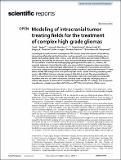| dc.contributor.author | Segar, David J. | |
| dc.contributor.author | Bernstock, Joshua D. | |
| dc.contributor.author | Arnaout, Omar | |
| dc.contributor.author | Bi, Wenya Linda | |
| dc.contributor.author | Friedman, Gregory K. | |
| dc.contributor.author | Langer, Robert | |
| dc.contributor.author | Traverso, Giovanni | |
| dc.contributor.author | Rampersad, Sumientra M. | |
| dc.date.accessioned | 2024-05-22T19:01:34Z | |
| dc.date.available | 2024-05-22T19:01:34Z | |
| dc.date.issued | 2023-01-30 | |
| dc.identifier.issn | 2045-2322 | |
| dc.identifier.uri | https://hdl.handle.net/1721.1/155041 | |
| dc.description.abstract | Increasing the intensity of tumor treating fields (TTF) within a tumor bed improves clinical efficacy, but reaching sufficiently high field intensities to achieve growth arrest remains challenging due in part to the insulating nature of the cranium. Using MRI-derived finite element models (FEMs) and simulations, we optimized an exhaustive set of intracranial electrode locations to obtain maximum TTF intensities in three clinically challenging high-grade glioma (HGG) cases (i.e., thalamic, left temporal, brainstem). Electric field strengths were converted into therapeutic enhancement ratios (TER) to evaluate the predicted impact of stimulation on tumor growth. Concurrently, conventional transcranial configurations were simulated/optimized for comparison. Optimized intracranial TTF were able to achieve field strengths that have previously been shown capable of inducing complete growth arrest, in 98–100% of the tumor volumes using only 0.54–0.64 A current. The reconceptualization of TTF as a targeted, intracranial therapy has the potential to provide a meaningful survival benefit to patients with HGG and other brain tumors, including those in surgically challenging, deep, or anatomically eloquent locations which may preclude surgical resection. Accordingly, such an approach may ultimately represent a paradigm shift in the use of TTFs for the treatment of brain cancer. | en_US |
| dc.language.iso | en | |
| dc.publisher | Springer Science and Business Media LLC | en_US |
| dc.relation.isversionof | 10.1038/s41598-023-28769-9 | en_US |
| dc.rights | Creative Commons Attribution | en_US |
| dc.rights.uri | https://creativecommons.org/licenses/by/4.0/ | en_US |
| dc.source | Springer Science and Business Media LLC | en_US |
| dc.title | Modeling of intracranial tumor treating fields for the treatment of complex high-grade gliomas | en_US |
| dc.type | Article | en_US |
| dc.identifier.citation | Segar, D.J., Bernstock, J.D., Arnaout, O. et al. Modeling of intracranial tumor treating fields for the treatment of complex high-grade gliomas. Sci Rep 13, 1636 (2023). | en_US |
| dc.contributor.department | Koch Institute for Integrative Cancer Research at MIT | |
| dc.contributor.department | Massachusetts Institute of Technology. Department of Mechanical Engineering | |
| dc.relation.journal | Scientific Reports | en_US |
| dc.eprint.version | Final published version | en_US |
| dc.type.uri | http://purl.org/eprint/type/JournalArticle | en_US |
| eprint.status | http://purl.org/eprint/status/PeerReviewed | en_US |
| dc.date.updated | 2024-05-22T18:36:51Z | |
| dspace.orderedauthors | Segar, DJ; Bernstock, JD; Arnaout, O; Bi, WL; Friedman, GK; Langer, R; Traverso, G; Rampersad, SM | en_US |
| dspace.date.submission | 2024-05-22T18:36:53Z | |
| mit.journal.volume | 13 | en_US |
| mit.journal.issue | 1 | en_US |
| mit.license | PUBLISHER_CC | |
| mit.metadata.status | Authority Work and Publication Information Needed | en_US |
